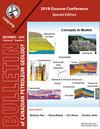波控边缘的相、测井模式、几何形状和层序地层学:来自加拿大不列颠哥伦比亚省阿尔伯塔省蒙特尼组的认识
Q3 Earth and Planetary Sciences
引用次数: 24
摘要
通过对加拿大西部沉积盆地早三叠世蒙特尼组的测井资料、岩心和露头资料的分析,建立了盆地尺度的层序地层格架。从石油勘探中获得的非常密集和约束良好的数据库(2200口井,18个岩心和4个露头)使得实现和测试用于古波浪主导边缘层序地层分析的通用工作流程和术语成为可能。根据岩心和露头的相定义以及相关测井模式的识别,两步方法允许大规模几何形状的重建:1)曲面和单元的模型无关定义;2)基于沉积层序模型的层序边界和体系域解释。给出了不同沉积环境的典型相组合和测井模式,包括潮汐环境,以及波浪主导的前滨、滨面和近海环境。在盆地尺度上详细介绍了与地层面和体系域相关的特征沉积环境的空间分布。在其他研究结果中,本研究强调了两种不同类型层序边界的沉积相几何形状的差异:第一种层序边界的相几何形状与Haq等人(1988)的层序模型非常相似,而第二种层序边界的相几何形状与Hunt和Tucker(1992)的层序模型相似。这项工作表明,在高坡度斜坡上快速、高幅度的基准面下降期间,浊积岩更有可能发生,而在低坡度地形上缓慢、低幅度的基准面下降期间,强迫退岸面更有可能发生。本文章由计算机程序翻译,如有差异,请以英文原文为准。
Facies, well-log patterns, geometries and sequence stratigraphy of a wave-dominated margin: insight from the Montney Formation (Alberta, British Columbia, Canada)
This study illustrates a basin-scale sequence stratigraphic framework based on wireline well-logs, cores and outcrops from the Early Triassic Montney Formation in the Western Canada Sedimentary Basin. A very dense and well-constrained database (2200 wells, 18 cores and 4 outcrops) derived from petroleum exploration made it possible to implement and test common workflows and terminologies used for sequence stratigraphic analysis along an ancient wave-dominated margin. Following facies definition from cores and outcrops and recognition of associated well-log patterns, a two-step approach allows for the reconstruction of large-scale geometries: 1) the model-independent definition of surfaces and units; and 2) the interpretation of the sequence boundaries and systems tracts based on a depositional sequence model.
The typical facies association and log pattern of different sedimentary environments including tidal, as well as wave-dominated foreshore, shoreface and offshore settings are presented. The spatial distribution of characteristic sedimentary environments associated with stratigraphic surfaces and systems tracts is also detailed at the basin scale. Among other results, this study highlights the differences in the sedimentary facies geometries across two different types of sequence boundaries: the facies geometries of the first sequence boundary are quite similar to Haq et al. (1988) sequence model, whereas the geometries of the second are similar to the Hunt and Tucker (1992) sequence model. This work shows that during a rapid, high amplitude base level fall on a high gradient slope, turbidites are more likely to occur, whereas, during slow, low amplitude base level fall on a low gradient topography, forced regressive shoreface will be more likely to occur.
求助全文
通过发布文献求助,成功后即可免费获取论文全文。
去求助
来源期刊

Bullentin of Canadian Petroleum Geology
Earth and Planetary Sciences-Geochemistry and Petrology
CiteScore
2.50
自引率
0.00%
发文量
0
期刊介绍:
The Bulletin of Canadian Petroleum Geology is a peer-reviewed scientific journal published four times a year. Founded in 1953, the BCPG aims to be the journal of record for papers dealing with all aspects of petroleum geology, broadly conceived, with a particularly (though not exclusively) Canadian focus. International submissions are encouraged, especially where a connection can be made to Canadian examples.
 求助内容:
求助内容: 应助结果提醒方式:
应助结果提醒方式:


